4 Kinds Of Amish Gardens
With May upon us, new life is springing up everywhere we look — perhaps nowhere more apparent than in our gardens. And in Amish communities, it’s a rare home without a garden of some sort.
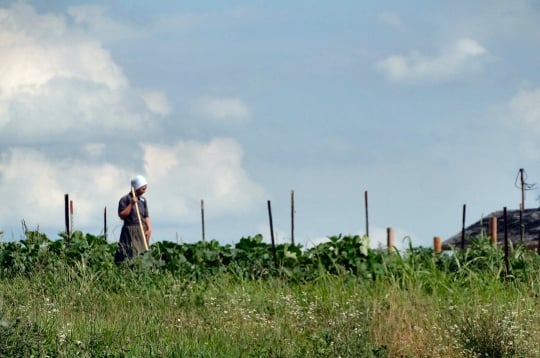
But Amish homes are not all the same, and the typical garden you see in one community may be different or absent in another. Let’s have a look today at four types of Amish gardens.
4 Types Of Gardens Tended By The Amish
1. Vegetable Garden – let’s start with the most ubiquitous of all. Amish of all stripes grow and can much of the food they eat. Amish vegetable gardens are oversized compared to those of English household. And that makes perfect sense when you consider the size of Amish families, and the still-strong custom of growing and canning a lot of what ends up on the table.
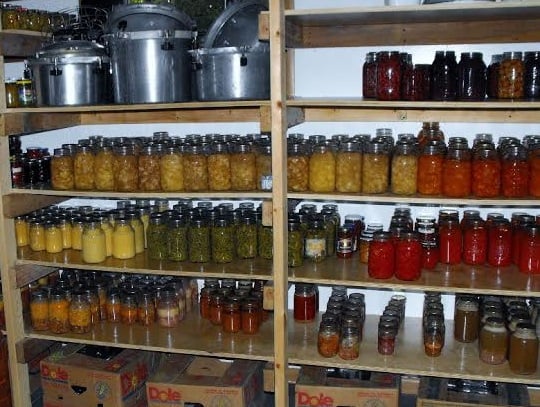
In their study of Amish gardens, authors David McConnell and Marilyn Loveless found a great discrepancy in size of Amish gardens vs. those of the English. The average garden of most Amish affiliations studied were at least two to three times larger than the equivalent English average garden.
And in the plainest homes, vegetable gardens may even be an incredible 15 to 20 times larger than English gardens. These gardens dwarf even those of their “higher” Amish neighbors. This suggests that the plainest Amish depend on home-grown food to a much greater degree than their more progressive cousins (see Nature & The Environment in Amish Life, pp 53-56).
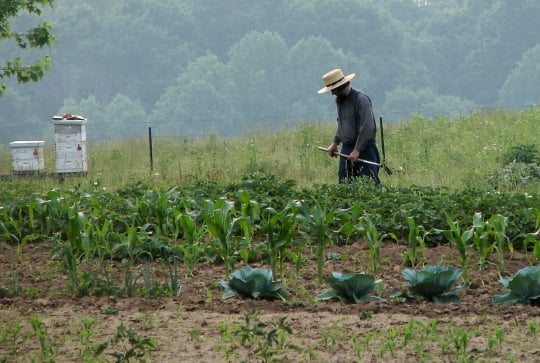
The Amish also can a lot more than English do – five to twelve times as many quarts annually as the average English home. For that matter, they aren’t canning just what they grow themselves. The may also purchase fresh fruits and vegetables from other sources to can themselves. One of my Amish friends in Pennsylvania, for instance, buys fruit for canning from a local Mennonite-owned orchard.
The more progressive Amish rely less on canned goods as they tend to purchase more of the foods they eat. That said, a vegetable garden remains an important source of both fresh and canned food providing for large and hungry Amish families year-round.
2. Flower Garden – Amish families appreciate the beauty provided by their often extensive flower gardens. From Nature & The Environment in Amish Life:
Flower gardens offer Amish women and men a creative outlet, with nature itself as the palette. They are places where one can feel inspired, nurtured, and safe. For the gardener, they are personal spaces where one can nurture plants and objects that realize one’s notion of beauty. An Old Order woman recollected, “My grandma was a serious gardener, and she had a huge garden, way more than she needed. My dad also loved gardening. Grandma was a weeder, she taught that to me. She had roses, the nicest roses, and mums, peonies. When she was older, we helped her spade her garden. She taught me about how to redo the mums. All our children had their own gardens.” While most Amish gardens are not formal, they are certainly planned and bring together plants that are beautiful, useful, and perhaps even meaningful. (p. 129)
For some reason the first flower I think of when I think of an Amish garden is the cockscomb. It’s always struck me as one of the oddest flowers. You often see it in Amish gardens.
Garden products can of course provide a source of side income. Some Amish sell flowers alongside canned goods at roadside stands. Others run full-fledged greenhouses.
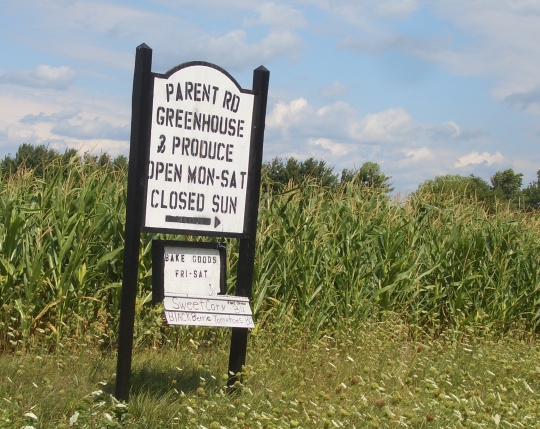
While many Amish yards feature beautiful gardens and professional-level landscaping, there are other Amish homes which have little to nothing of the sort:
Among the conservative Swartzentruber Amish, vegetable gardens are a given, but flowers are seldom used as a landscaping tool. One former Swartzentruber man told us, “We were not allowed to have flowers.” A man from the Geauga settlement agreed. “We were always told that the beauty of nature is…what’s the right word? To dress up our front yards with flowers was prideful.” The man’s wife recounted, “My mom liked flowers. But she had her flowers planted in the tea bed, where the tea was grown. I remember, having church at our house, she’d actually pull all of the flowers off so the people don’t have to see the flowers.” (Nature & The Environment in Amish Life, p. 131)
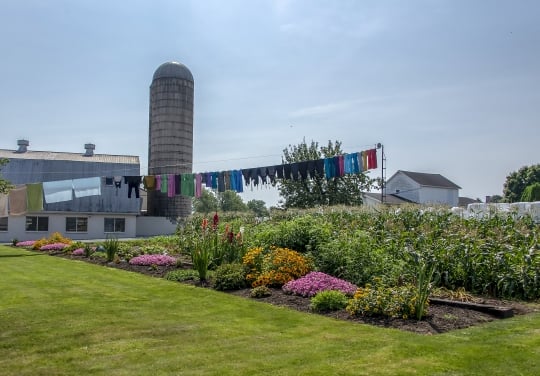
So as with other markers of culture, the flower garden serves as a something of a line between Amish groups. The most easily-noticed example of this is in Holmes County, Ohio, where stark dirt-and-weeds Swartzentruber homesteads stand in contrast to Amish neighbors with immaculate lawns and contoured yards brimming with bright and colorful flowers.
3. Herb Garden – many Amish make use of herbal remedies, based both on plants collected in the wild and grown at home. Here is an account of one Amish woman’s herb garden, as reported in the Wooster Daily Record:
While Millie says she loves her vegetables and flowers, it’s clear her true delight is herb gardening. She and her husband began dabbling in herbs 20-plus years ago after a visit to an herb farm, and she now proclaims, “they’re my favorite.”
Apart from cooking with them, Millie enjoys using her herbs for medicinal purposes. While this practice is making a comeback in the “English” world, the Amish have been using these natural home remedies for generations.
Millie grows yarrow (for infections), feverfew (for headaches), St. John’s Wort (for nerves), and horehound (for coughs and the flu), among others.
She said she loves to steep some lime mint in a jar of fresh water to make tea. “The men wonder what kind of weeds I’ve got sitting in there, but it’s so good,” she said.
Millie also grows loveage, which she uses like celery, and chervil, which she pronounces “nice to cook with.” She’s also made cakes and cookies with herbs such as lavender and scented geraniums.
As noted, herbs have a long history with the Amish. The authors of Nature & The Environment in Amish life write: “A kitchen garden, containing potherbs, remedies, and other useful species, is a common feature of traditional communities around the world and harks back to the earliest farming experiences of the Amish community in Europe.” (p. 127).
I’d have to say my favorite product of Amish herb gardens is an ice cold glass of fresh meadow tea.
4. Memory Garden – A memory garden is planted to commemorate the life of a lost loved one, a living memorial to departed family and friends. Author Vanetta Chapman shares a nice photo of an Amish memory garden on her site:
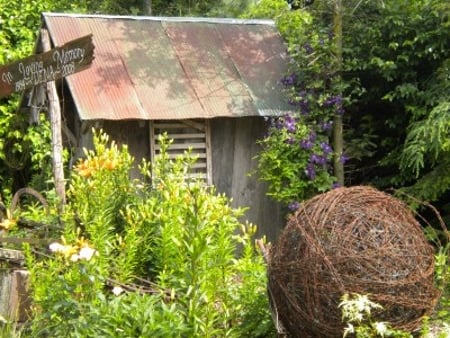
Vanetta writes “Occasionally you’ll find a memory garden. The top right picture is one of my favorites. See the wooden marker? What a lovely way for this family to remember a loved one.”
Pomerene Hospital in Millersburg, Ohio has a section of land dedicated to a memory garden. This is one of the main hospitals serving the Holmes County Amish community. McConnell and Loveless describe another memory garden in the settlement:
An older Andy Weaver woman took us into her yard and showed us the small area she had created as a memory garden for her husband, who had died the previous year. Located in front of a white picket fence, it contained only species whose flowers were pure white. (p. 129)
A memory garden is a living remembrance of a loved one that can be enjoyed and make a place to reminisce. It’s a natural place to be enjoyed but one imbued with meaning.
More than just food and decoration
On that note, it’d be good to close by noting the connection between gardens and God: “There are dozens of references in the Bible to gardens and the fruits and flowers, herbs and spices they yield. They are refuges, sources of nourishment, and places of water.”
Gardens are often used in sermons, as an Amish minister explains: “Your preaching illustrations come out of everyday-ness and so if you garden, there’s illustrations. So church purity might be metaphored to a garden with weeds, and how it takes effort to keep the weeds out, how the young plants must be protected.” Another Amishman the authors spoke with said simply “The Lord is a partner in the garden.” (Nature & The Environment in Amish Life, p. 128-129).
For the Amish, gardening is a productive and wholesome activity which involves the whole family, from the youngest to the oldest. It helps children learn good work habits, provides a creative outlet for Amish of all ages, and gives the oldest a practical, doable activity to enjoy even in later years. It literally puts food on the table, but serves as much more than just a source of meals.
So the garden provides for both the body and soul in some sense. Consider that the next time you enjoy canned goods from an Amish garden, or admire the well-tended flower beds adorning Amish homes.






A question
What is that large-ish brown ball on the right in the memory garden photo?
Looks like wire.
I am not sure, but I agree it does look like a ball of rusted wire. Is that a decorative element of the garden? I will see if Vanetta knows.
i sure miss not having a garden. My parents used to have two large gardens and two big freezers to put their frozen strawberries and vegetables. dad had even dug a root cellar for his potatoes. i miss the fresh corn, green beans, cucumbers and zucchini we grew. So much better than store bought.
Wire ball
Yes, as far as I know it’s just a giant ball made of old wire found around the farm. My grandmother used to say that if you put something rusty in your garden, the flowers would grow better. I also thought this was a great example of using what’s on hand…
Thanks, Vanetta. Never heard of that. I wonder if that belief is alive in this example as well.
I’ve observed on Amish homesteads three of the four types of gardens mentioned; haven’t seen a memory garden but am looking forward to seeing one sometime. Several times each year I visit two very plain Amish settlements in southern Indiana, as well as the large more progressive settlement in the Elkhart/Lagrange area in northern Indiana. It is interesting to observe differences in gardening. It seems like every homestead I visit in the plainer settlements has a large garden. In the Elkhart/Lagrange settlement I still see many gardens, but it seems like on some of the smaller, newer homesteads there is either no garden or else a very small one.
In regards to canning — in the plainer communities there is usually one or two households that places very large orders (like one or two hundred bushels) of fruits such as peaches, pears, apples, etc. for households in the whole community to can. The fruits usually come from quite a distance away in other states. Also, I remember visiting a family in southern Indiana in late July a few years ago and they were canning canteloupe.
I’d never heard of canned canteloupe. The mother in the home told me they had such a bumper crop of canteloupe in their garden that they were canning all they couldn’t eat fresh. I think I remember her also saying “Can what you can, and what you can’t eat can.”
Al the two photos showing people by Cindy Cornett Seigle are actually from southern Indiana, the plain group in Orange County I believe. She has several others of Amish gardens. They seem pretty sizeable.
I would be up for trying some “cannedeloupe.”
Sorry, couldn’t let that one go:)
Thanks for the comments regarding the pictures. The style of clothing/hat/kapp certainly looks like the styles worn in the Swartzentruber settlement in Orange/Lawrence County, Ind. If the pictures were just a little larger showing more of the farmstead(s), I would likely know whose farmstead(s) they are. That community has really spread out as it has grown to four districts. I would say that at least half of the farmsteads sell one or more types of produce from their farms each growing season. Good produce at very reasonable prices.
Heavens
https://youtu.be/_f5rOLWPS4w
Medecinal garden
From here in Alsace (France), the garden of Nicolas Augsburger (1800-1890), which was an emblematic and charismatic figure of the Amish movement in Alsace, was composed of medicinal plants which he made remedies for men and animals. People came from far and wide for his remedies. Even today, next to the house he lived in, the garden is still there.With us many Amish were known to compose natural remedies with plants, knowledge which they undoubtedly already brought back from Switzerland.
Amish flowers
Can you tell me where the Amish purchase their flower seeds from?
Is there a particular catalog, etc. I love their flower gardens and
am searching for cockscomb seeds. Thank you for your assistance.
I enjoyed reading the article and noted both vegetables and flowers in some Amish gardens I saw in the Sturbridge, Michigan, area when I visited. While my husband and I are city (actually suburban) dwellers, we have a patio garden and enjoy growing some flowers and some vegetables. We also belong to a veggie co-op where the vegetables and some fruits are grown on an organic farm north of the area where we live. It’s such fun to receive fresh veggies weekly.
Thanks for the excellent article.